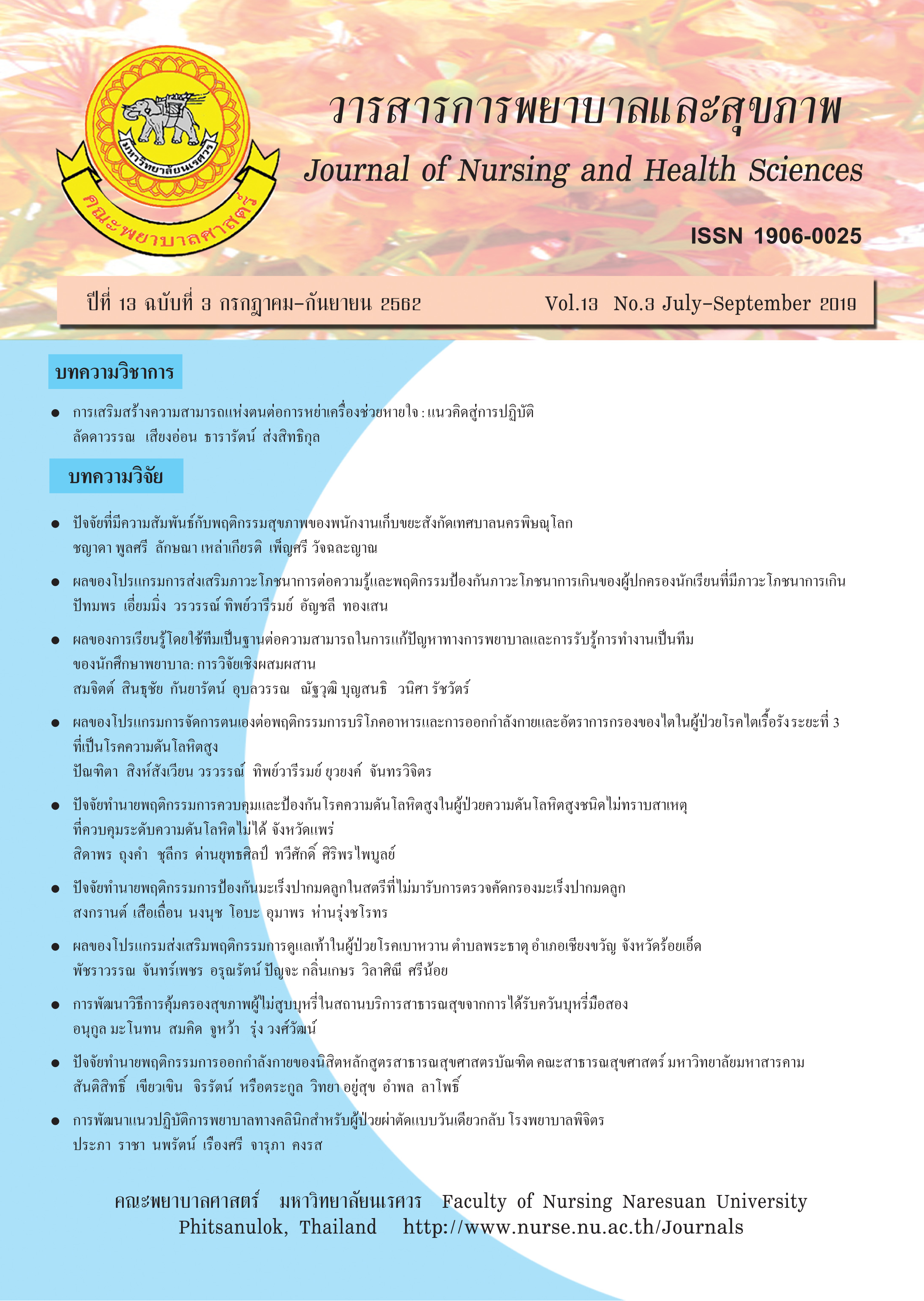การเสริมสร้างความสามารถแห่งตนต่อการหย่าเครื่องช่วยหายใจ : แนวคิดสู่การปฏิบัติ
Main Article Content
บทคัดย่อ
พยาบาลวิชาชีพเป็นผู้มีบทบาทสำคัญในการให้การดูแลผู้ป่วย โดยเฉพาะผู้ป่วยที่เข้ารับการรักษาในหอผู้ป่วยหนักที่มีภาวะการหายใจล้มเหลวต้องใช้เครื่องช่วยหายใจเป็นเวลานานโดยที่ไม่สามารถหย่าเครื่องช่วยหายใจได้ โดยพบว่าสาเหตุส่วนใหญ่เกิดจากปัจจัยทางด้านสรีรวิทยา และปัจจัยด้านการรับรู้ โดยปัจจัยด้านการรับรู้รวมถึงการรับรู้ความสามารถของตนเองสามารถพัฒนาได้โดยใช้แหล่งข้อมูล 4 แหล่งคือ (1) การใช้ตัวแบบ (Mdeling) (2) ประสบการณ์ที่ประสบความสำเร็จ (Mastery experiences) (3) การกระตุ้นทางอารมณ์ (Emtinal arusal) และ (4) การชักจูงด้วยคำพูด (Verbal persuasin) (Bandura, 1977) ดังนั้นหากพยาบาลสามารถใช้ประโยชน์จากแหล่งข้อมูลทั้ง 4 แหล่ง มาพัฒนาให้ผู้ป่วยสามารถรับรู้ความสามารถของตนเองในการหย่าเครื่องช่วยหายใจร่วมกับการให้กำลังใจกับผู้ป่วย จะเป็นแนวทางที่จะช่วยให้ผู้ป่วยสามารถประสบผลสำเร็จในการหย่าเครื่องช่วยหายใจได้ตามที่คาดหวัง
Article Details
เอกสารอ้างอิง
Bandura, A. (1977). Social learning theory. Englewood Cliffs, N.J.: Prentice-Hall.
Burns, S.M., Fisher, C.E., Tribble, S.S., Lewis, R., Merrel, P., Conaway, M.R., …Bleck, T.P. (2010). Multifactor clinical score and outcome of mechanical ventilation weaning trials : Burns wean assessment program. American Journal Critical Care, 19(5), 431-439.
De, Jonghe B., Bastuji-Garin, S., Durand, M.C., Malissin, I., Rodrigues, P., Cerf, C., …Sharshar, T. (2007). Respiratory weakness is associated with limb weakness and delayed weaning in critical illness, Critical Care Medicine, 35(9), 2007-2015.
Leo, M. H., & Van Der Hoeven J.G. (2010). Clinical review: The ABC of weaning failure - a structured approach. Critical Care, 14(6), 1-9.
Klinchet, N., Wattanakitkrileart, D., Charoenkitkarn, V., & Wongsurakiat, P. (2015). Influences of creatinine clearance, cough effectiveness, perceived sleep quality, perceived ... breathing trial in patients with simple ventilator weaning. Journal of The Royal Thai Army Nurses, 16(3), 105-113. [In Thai].
Kumar, G., Majumdar, T., Jacobs, E.R., Danesh, V., Dagar, G., Deshmukh, A., …Nanchal, R. (2013). Outcomes of morbidly obese patients receiving invasive mechanical ventilation. Chest Journal, 144(1), 48-54.
Mamary, A.J., Kondapaneni, S., Vance, G.B., Gaughan, J.P., Martin, U.J., & Criner, G.J. (2011). Survival in patients receiving prolonged ventilation: Factors that influence outcome. Clinical Medicine Insights : Circulatory, Respiratory and Pulmonary Medicine, 5, 17–26.
McConville, F. John., & Kress, P. John. (2012). Weaning patients from the ventilator. The New England Journal of Medicine, 367(23), 2233-2239.
Pachakawe, M., Binhsen,V., & Pakdevong, N. (2019). Factors predicting outcome of extubation in critically Ill patients in intensive care unit, Singburi Hospital. Journal of Nursing and Health Care, 37(1), 108-117. [In Thai].
Pathomjaruwat, T., Wattanakitkrileart, D., Pinyopasakul, W., & Wongsurakiat, P. (2013). Correlation between awareness of self performance, of disorder severity and of anxiety, and duration of spontaneous breathing trial in patients not having been weaned off respirators. Thai Journal of Nursing Council, 28(1), 49-63. [In Thai].
Perren, A., Previsdomini, M., Llamas, M., Cerutti, B., Györik, S., Merlani, G.,…Jolliet, P. (2010). Patients' prediction of extubation success. Intensive Care Medicine, 36(12), 2045-2052.
Ramadan, M. Nafae., Mohammed, A. Mohammed., Amani, F. Morsi ., & Dalia, A. Ibrahim. (2014). Thyroid function in respiratory failure patients. Egyptian Journal of Chest Diseases and Tuberculosis, 63(2), 513-521.
Ranron, T. (2014) Predicting factor of successful weaning from mechanical ventilator in critically ill patients. Master Thesis (Nursing), Chulalongkorn University, Bangkok. [In Thai].
Salam, A., Tilluckdharry, L., Amoateng-Adjepong, Y., & Manthous, C.A. (2004). Neurologic status, cough, secretions and extubation outcomes. Intensive Care Medicine, 30(7), 1334-1339.
Savi, A., Teixeira, C., Silva, J.M., Borges, L.G., Pereira, P.A., Pinto, K.B., …Vieira, S.R. (2012). Weaning predictors do not predict extubation failure in simple-to-wean patients. Journal of Critical Care, 27(2), 221-228.
Sing Buri Hospital. (2016). Intensive care nurse service quality report, Nursing mission group, Sing Buri. Sing Buri: Sing Buri Hospital. [In Thai].
Su, W.L., Chen, Y.H., Chen, C.W., Yang, S.H., Su, C.L., Perng, W.C., …Chen, J.H. (2010). Involuntary cough strength and extubation outcomes for patients in an ICU. Chest Journal, 37(4), 777-782.
Tiasawat, U., Saensom, D., Namuangchan, A., Tansura, S., Boonloy, Y., & Songserm, A. (2017). Development of a clinical nursing practice guideline for mechanically ventilated patients in critical care department, Khon Kaen Hospital. Journal of Nursing and Health Care, 35(1), 194-206. [In Thai].
Twibell, R., Sicla, D., & Mahmoodi, M. (2003). Subjective perception and physiological variables during weaning from mechanical ventilation. American Association of Critical Care, 12(2), 104-112.
Udchumpisai, M., Na Ayuthya, K., Pongthavornkamon, K., & Wngsurakiat, P. (2010). Factors influencing prolonged mechanical ventilation in critically-ill medical patients. Thai Journal of Cardio-Thoracic Nursing, 21(1), 14-30. [In Thai].


